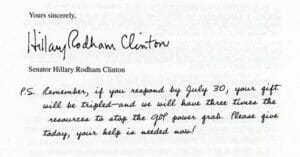A guest post by John Killoran, Clover Leaf Solutions
Did you know that nonprofits are more likely to reach their fundraising goals when they host in-person or hybrid events? Planning a face-to-face fundraiser is a big job, but it pays off. With solid event management tips, your nonprofit can do more than reach its fundraising goals—you can inspire continuous support and secure donor loyalty for the long haul.
That’s where this guide comes in! Let’s review three event management tips to help your nonprofit’s next event exceed expectations.
1. Create an event-planning calendar.
Most event management activities happen before the event even starts. To host a successful fundraiser, your team must have plenty of time to plan it.
This means you’ll need to create a timeline for when each event-planning task will take place. For example, let’s say your nonprofit is hosting a silent auction. Your calendar may look something like this:
- 10 months before the event
-
-
- Define the purpose and goals of your event
- Create an event plan, including logistics like event date and venue
- Establish an event budget
- Choose fundraising software
- Set up a procurement committee to acquire auction items
- Create an auction marketing plan
-
- Six months before the event
-
-
- Choose auction items for your item catalog
- Reach out to potential event sponsors
- Plan volunteer roles and schedules
- Start promoting the event on social media
- Order any custom printing service items, like event signage
-
- Two months before the event
-
-
- Open event registration
- Recruit volunteers
- Plan your follow-up materials to thank donors and volunteers
- Test event technology
- Finalize catering
-
- Two weeks before the event
-
- Close registration and finalize attendance headcount
- Finalize your timeline for the day of the event, including set-up and breakdown
- Organize day-of supplies
- Train volunteers on event procedures
- Make a final event promotion push on social media
Remember, this calendar is dedicated to all your pre-event tasks. Create a separate calendar for day-of activities to keep your to-do list organized.
2. Engage with your audience.
When it comes to generating excitement about your event, you’ll have to do more than just tell people it’s happening. Your communication strategy should get donors excited about your fundraiser!
To do this, use a variety of outreach types, including:
- Direct outreach. Many nonprofits focus their marketing efforts on general swaths of donors, volunteers, or potential supporters. While this audience is important, don’t forget the individuals already in your corner! Personally reaching out to stakeholders already invested in your nonprofit’s success, like existing donors, volunteers, board members, and corporate partners, makes them more likely to attend.
- Personalized outreach. Custom outreach hones in on why specific audiences should be interested in your event, making them more likely to attend. Use what you know about individual donors to create personalized messaging that appeals to them. For example, tell a college-aged supporter about the dorm decorations you’re auctioning off at your fundraiser.
- Broad outreach. Use communication channels that target entirely new audiences. For example, social media posts can appear in front of users who don’t follow your nonprofit’s account. Also, internet searchers can stumble upon your nonprofit’s website if you market it correctly. As NXUnite explains, search tools increase your nonprofit’s visibility online. By driving more traffic to your website, you can engage a bigger audience than ever before.
Beyond spreading the word about your event, you can also use these strategies to follow up after the fundraiser. For example, broad outreach might include sharing photos and fundraising results on your social media channels. Save your personalized outreach to thank attendees individually.
3. Use fundraising software.
There’s plenty for your team to do when planning your fundraiser. But the right tools can make the difference between simply executing your plans and improving overall efficiency.
Fundraising software can handle everything from event registration to payment processing and donor communications. How do you choose the right tool to manage your event? It depends on what type of event you’re hosting.
Let’s think back to our example of an auction fundraiser. Snowball’s auction software guide recommends following these three steps:
- Determine your nonprofit’s needs. Think about how you’ll make your fundraiser happen. For example, what tools do you need to run it? What features would help you engage donors? Answering these questions can narrow your search for a tool that meets your nonprofit’s specific needs.
- Set a budget. The amount your nonprofit spends on fundraising software depends on the features it offers—but you should still spend wisely. If you purchase all-in-one software, you can use the same tool to host different fundraisers. In other words, you’ll get more bang for your buck.
- Compare products. Gather a list of potential software providers and choose the one that stands out the most. To ensure you make the right choice, schedule a demo and meetings with product experts first to see your favorite tools in action.
For the best results, choose fundraising software with multiple capabilities. A solution that can manage auctions, mobile giving campaigns, and a host of other fundraisers will have more than enough features to run a successful event. This way, your nonprofit can diversify its funding streams and raise more overall.
John Killoran is an inventor, entrepreneur, and the Chairman of Clover Leaf Solutions, a national lab services company. He currently leads Clover Leaf’s investment in Snowball Fundraising, an online fundraising platform for nonprofit organizations.
Snowball was one of John’s first public innovations; it’s a fundraising platform that offers text-to-give, online giving, events, and peer-to-peer fundraising tools for nonprofits. By making giving simple, Snowball increases the donations that these organizations can raise online. The Snowball effect is real! John founded Snowball in 2011. Now, it serves over 7,000 nonprofits and is the #1 nonprofit fundraising platform.



